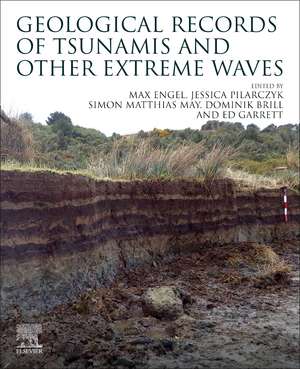Geological Records of Tsunamis and Other Extreme Waves
Editat de Max Engel, Jessica Pilarczyk, Simon Matthias May, Dominik Brill, Ed Garretten Limba Engleză Paperback – 22 iul 2020
The effectiveness of paleotsunami records in coastal hazard-mitigation strategies strongly depends on the appropriate selection of research approaches and methods that are tailored to the site-specific environment and age of the deposits. In addition to summarizing the state-of-the-art in tsunami sedimentology, Geological Records of Tsunamis and Other Extreme Waves guides researchers through establishing an appropriate research design and how to develop reliable records of prehistoric events using field-based and laboratory methods, as well as modeling techniques.
- Features a comprehensive overview of the state of the art in tsunami sedimentology and paleotsunami research
- Offers advice on the most appropriate mapping, sampling, and analytical approaches for a wide variety of coastal settings and sedimentary environments
- Provides methodological details for field sampling and the most important proxy analyses
Preț: 928.43 lei
Preț vechi: 1290.22 lei
-28% Nou
Puncte Express: 1393
Preț estimativ în valută:
177.65€ • 185.12$ • 147.10£
177.65€ • 185.12$ • 147.10£
Carte tipărită la comandă
Livrare economică 27 martie-10 aprilie
Preluare comenzi: 021 569.72.76
Specificații
ISBN-13: 9780128156865
ISBN-10: 0128156864
Pagini: 848
Dimensiuni: 191 x 235 mm
Greutate: 1.43 kg
Editura: ELSEVIER SCIENCE
ISBN-10: 0128156864
Pagini: 848
Dimensiuni: 191 x 235 mm
Greutate: 1.43 kg
Editura: ELSEVIER SCIENCE
Public țintă
Geologists, Geochemists, Sedimentologists, Coastal Geomorphologists, Seismologists, Coastal PlannersCuprins
SECTION 1 Introduction
1 Geological records of tsunamis and other extreme waves: concepts, applications and a short history of research
2 Historical records: their importance in understanding and mitigating tsunamis
3 Tsunami magnitude scales
4 Trigger mechanisms and hydrodynamics of tsunamis
5 Tsunami databases
6 Onshore archives of tsunami deposits
SECTION 2 Field methods
7 Geophysical prospection and sedimentological characteristics of subaquatic tsunami deposits
8 Ground-penetrating radar (GPR) in coastal hazard studies
9 Mapping of subaerial coarse clasts
10 Post-event field surveys
SECTION 3 Fine-Grained deposits
11 The sedimentology and geometry of fine-grained tsunami deposits from onshore environments
12 Foraminifera in tsunami deposits
13 Ostracoda in extreme-wave deposits
14 Diatoms in tsunami deposits
15 The application of molluscs for investigating tsunami deposits
16 Magnetic susceptibility and anisotropy of magnetic susceptibility: versatile tools to decipher hydrodynamic characteristics of past tsunamis
17 X-ray tomography applied to tsunami deposits
18 Applications of geochemical proxies in paleotsunami research
19 Microtextures in tsunami deposits: a useful sediment fingerprinting tool
20 Paleogenetic approaches in tsunami deposit studies
21 Post-depositional changes to tsunami deposits and their preservation potential
22 Erosional signatures and reorganization in ridge-and-swale sequences
23 Experimental and numerical models of fine sediment transport by tsunamis
SECTION 4 Coarse-Clast deposits
24 Spatial patterns of subaerial coarse clasts
25 Mega-tsunami deposits related to ocean island flank collapses and asteroid impacts
26 Erosive impact of tsunami and storm waves on rocky coasts and postdepositional weathering of coarse-clast deposits
27 Experimental models of coarse-clast transport by tsunamis
28 Reconstruction of transport modes and flow parameters from coastal boulders
29 Perspective of incipient motion formulas:boulder transport by high-energy waves
SECTION 5 Dating
30 Radiocarbon dating of tsunami and storm deposits
31 Radiocarbon and U/Th dating of tsunami and storm-transported coarse clasts
32 Optically stimulated luminescence dating of tsunami and storm deposits
33 Archaeological dating of tsunami and storm deposits
34 Tephrostratigraphy and tephrochronology
35 Cosmogenic nuclide dating of coarse clasts References
36 Paleomagnetic dating of wave-emplaced boulders
1 Geological records of tsunamis and other extreme waves: concepts, applications and a short history of research
2 Historical records: their importance in understanding and mitigating tsunamis
3 Tsunami magnitude scales
4 Trigger mechanisms and hydrodynamics of tsunamis
5 Tsunami databases
6 Onshore archives of tsunami deposits
SECTION 2 Field methods
7 Geophysical prospection and sedimentological characteristics of subaquatic tsunami deposits
8 Ground-penetrating radar (GPR) in coastal hazard studies
9 Mapping of subaerial coarse clasts
10 Post-event field surveys
SECTION 3 Fine-Grained deposits
11 The sedimentology and geometry of fine-grained tsunami deposits from onshore environments
12 Foraminifera in tsunami deposits
13 Ostracoda in extreme-wave deposits
14 Diatoms in tsunami deposits
15 The application of molluscs for investigating tsunami deposits
16 Magnetic susceptibility and anisotropy of magnetic susceptibility: versatile tools to decipher hydrodynamic characteristics of past tsunamis
17 X-ray tomography applied to tsunami deposits
18 Applications of geochemical proxies in paleotsunami research
19 Microtextures in tsunami deposits: a useful sediment fingerprinting tool
20 Paleogenetic approaches in tsunami deposit studies
21 Post-depositional changes to tsunami deposits and their preservation potential
22 Erosional signatures and reorganization in ridge-and-swale sequences
23 Experimental and numerical models of fine sediment transport by tsunamis
SECTION 4 Coarse-Clast deposits
24 Spatial patterns of subaerial coarse clasts
25 Mega-tsunami deposits related to ocean island flank collapses and asteroid impacts
26 Erosive impact of tsunami and storm waves on rocky coasts and postdepositional weathering of coarse-clast deposits
27 Experimental models of coarse-clast transport by tsunamis
28 Reconstruction of transport modes and flow parameters from coastal boulders
29 Perspective of incipient motion formulas:boulder transport by high-energy waves
SECTION 5 Dating
30 Radiocarbon dating of tsunami and storm deposits
31 Radiocarbon and U/Th dating of tsunami and storm-transported coarse clasts
32 Optically stimulated luminescence dating of tsunami and storm deposits
33 Archaeological dating of tsunami and storm deposits
34 Tephrostratigraphy and tephrochronology
35 Cosmogenic nuclide dating of coarse clasts References
36 Paleomagnetic dating of wave-emplaced boulders
